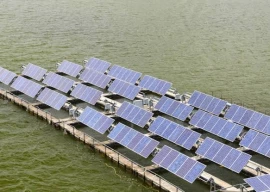
“The utmost priority in Pakistan’s energy sector is moving towards a diversified mix,” says Junaid Qurashi, CEO of the SSJD Group.
His company’s research shows the share of oil in the country’s energy portfolio has gone up further this year and currently stands at 35 per cent – more than one-third of the entire mix.
The heavy reliance on oil, a non-renewable resource, is not just alarming because of the high costs of procurement and massive burden on foreign exchange reserves. In Pakistan, the problem of circular debt has plagued the sector and it seems very unlikely it will be resolved anytime soon, especially after the devastating floods which have forced the government to reprioritise expenditure.
“We strongly believe in alternative energy generated through indigenous resources that are easily available locally,” said Qurashi in an exclusive interview with The Express Tribune.
Although SSJD already runs a 15-megawatt coal-fired power plant in Sindh, the company’s aim going forward is to provide electricity using renewable resources in order to ensure a long-term solution to Pakistan’s deepening power deficit.
The first step towards realising this goal is a 12-megawatt power plant that would rely exclusively on agricultural waste as a source of fuel, mainly baggase – a by-product of the sugar extraction process. In the long-run, it hopes to establish five such plants over a period of seven years.
Last week the company received a letter of interest from the Alternative Energy Development Board, indicating that the biomass project may be up and running in the first half of 2012. The plant is being established in the Mirpurkhas district and will supply energy to the national grid through the Hyderabad Electric Supply Company (Hesco).
Merry go ‘debt’
Contributing to the national grid may ease the power crisis to some extent but one cannot ignore the fact that expecting timely payment from the state-backed electricity supplier may be too optimistic a feat.
“We have taken all measures to protect our investors. At worst, we can expect a slight delay in payments but we do not anticipate the government defaulting on us,” responded Qurashi when questioned on how the company was confident it would not fall in the inter-corporate debt trap.
He explained that SSJD is backed by US-based insurance providers to cover not just political risks but also disruptions in income. “Many of our investors are from abroad and we are also working with the investment arm of a US government agency,” said Qurashi, who himself has recently moved back to Pakistan after spending 22 years in the US.
If the government defaults on payments, not only would its credibility be damaged but it could also deter important foreign institutions from investing in Pakistan,” claimed Qurashi.
It is also widely believed that it is in the interest of power purchasers to pay off the cheapest fuel source first, indicating that there may be some hope for those willing to invest in alternative energy schemes.
Why biomass?
With the rising popularity of other renewable fuel sources like wind, sunlight and water, a reasonable question to ask is: why biomass? Especially when financial ‘gurus’ are advising investors in next-door India to proceed with caution before pouring money into the initial public offering of Orient Green Power – a renewable energy developer seeking to scale up capacity.
“Our research shows that two million tons of agricultural waste is easily available just in Sindh alone and we estimate an additional three million is available in rest of the country annually. A 12-megawatt biomass plant requires only 160,000 tons per annum so there is no question that Pakistan can easily generate 300 megawatts though biomass fuel,” said Qurashi.
He also pointed out that even though the input (or ‘fuel’) costs of solar, wind and hydro electricity production are near zero, these plants are comparatively much more expensive to set up.
Qurashi estimated that the cost of setting up a plant making use of the more accepted renewable sources of energy ranged between two and five million dollars per megawatt.
“A biomass plant can be established for approximately $1.5 million per megawatt,” he shared.
Even though new studies are showing that the environmental impact of energy production through biomass may be less rosy than initially portrayed, it must be considered that in Pakistan most of the agricultural waste is inefficiently utilised – more often than not, it is simply burned in an uncontrolled environment.
Moreover, the positive economic impact of innovative solutions to tackle the energy crisis cannot be ignored. Biomass plants, for example, are likely to boost rural employment through the creation of a ‘collection’ industry working to acquire stocks of agricultural waste required to run the plant.
Published in The Express Tribune, September 22nd, 2010.











1734899716-0/image-(15)1734899716-0-270x192.webp)
1732012115-0/Untitled-design-(14)1732012115-0-270x192.webp)










COMMENTS (3)
Comments are moderated and generally will be posted if they are on-topic and not abusive.
For more information, please see our Comments FAQ